NGC 4755, also known as “The Jewel Box” cluster, is a young, open star cluster in the Constellation Crux located in the southern sky. NGC 4755 is approximately 6,440 lightyears from earth, with a Right Ascension of 12h53m39.499s and Declination of -60d22m15.6s. Its estimated age is approximately 14 million years and was originally discovered by Nicholas Louis De Lacaille in 1752. It later received the title of “The Jewel Box” cluster in 1854 when observed by John Herschel as he compared the cluster’s appearance to be that of a “superb piece of fancy jewellery.”
The cluster stars make up the shape of a letter ‘A’ that points to the west, with a bright red Supergiant star in the centre. The Milky Way Star Clusters Catalog (MWSC) records the 8 brightest members of the star cluster are B giants and Supergiants, with 23 central stars and 110 cluster stars in total. Unfortunately, as noted on in-the-sky.org, this cluster is not observable from Saskatoon because the cluster is so far in the southern sky and never rises above the horizon, however in the south it appears as a hazy/fuzzy star to the unaided eye.
To fully investigate this cluster and the relationship between its colour and brightness, along with its chemical composition make up, I set up Skynet Robotic Telescopes to observe and collect 1 -3sec image an hour in each of its blue (B), green (V), and red (R) filters over a span of 5 hours, for a total of 15 images.

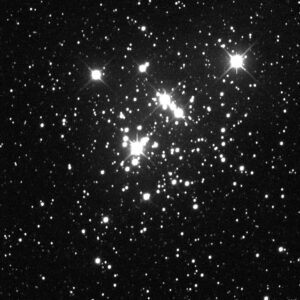
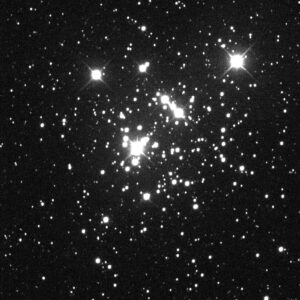
I then imported the data and images to Afterglow, an image processing website, to stack the images together and create colour imaging of the cluster from the black and white Skynet originals. I produced two colour images of the cluster, one with Interstellar Reddening (ISM) to show how the cluster would appear to us as if we were able to see it from earth, and the other image a De-Reddened version to show the cluster in it’s truest form in space.
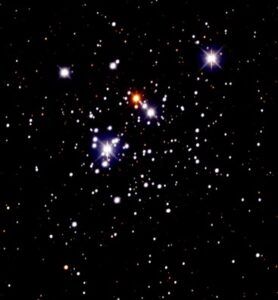
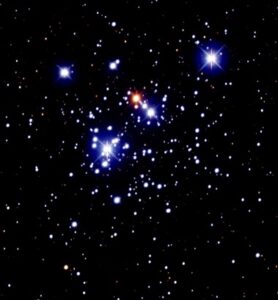
In order to produce this De-Reddened image, I also had to use the Cluster Pro Plus software to import my Skynet and Afterglow data and fit it to an Isochrone model. Fitting a cluster’s data to an Isochrone model is essential as it is the only way to measure the star cluster’s age by looking at its main sequence turnoff point. As we fit the Isochrone to the data points, we arrive at some important values to note, such as the cluster’s proper motion, its distance, log age, metallicity, and the Interstellar Reddening and extinction (E(B-V)). This E(B-V) value is important to know as we can use it in the Afterglow Photometry imaging to take away the Interstellar Reddening in the image, therefore creating the De-Reddened image.
The Isochrone models that I developed using Cluster Pro Plus software:
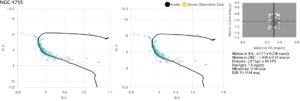
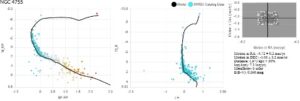
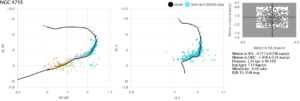
After fitting the Isochrone models, I was able to make a table that shows the parameters of the star cluster’s details, comparing my values I recorded to the values in the GAIA and 2MASS catalog and also the Milky Way Star Cluster Catalog:
| Proper Motion in Right Ascension (mas/yr) | Proper Motion in Declination (mas/yr)) | Distance (kpc) |
Log(Age) (log(yr)) |
Metallicity (solar mass units) | Interstellar Reddening Extinction E(B-V)
(mag) |
|
| My Skynet Data | -4.717 +/-0.238 | -1.038 +/-0.25 | 2.07 | 7.4 | 0.34 | 0.44 |
| GAIA & 2MASS data | -4.72 +/-0.2 | -1.05 +/-0.2 | 2.31 | 7.16 | -0.02 | 0.45 |
| MWSC catalog | -4.72 +/-0.2 | -1.05 +/-0.2 | 1.971 | 7.3 | 0 | 0.396 |
Fun Facts about NGC 4755:
- When we convert the distance of 6,440 lightyears to kilometres, we calculate this cluster to be about 60,927,000,000,000,000 kms away from us. That’s the equivalent to going around the Earth about 1,520,324,391,765 times!!
- Driving to the Jewel Box cluster at a speed of 120mph would take you about 35,766,220,213.33 years!
- NGC 4755 is the 12th brightest open cluster
- Other names that NGC4755 has also been known as are: Kappa Crucis Cluster, Caldwell 94, Cr 264
- The Constellation Crux, where NGC 4755 is located within, is centred on 4 stars in a cross-shaped asterism that is commonly known as the Southern Cross
Conclusion
Overall, I quite enjoyed this Star Cluster project. We got to learn how to set up our own observations, work with real data to analyze, and learn how to create coloured images of real celestial objects located more than millions of miles away. I’d like to thank our Professor, Daryl Janzen, for guiding us through this project so perfectly with his step-by-step instructions, along with the TA’s at the Help Desk for being available to answer questions and provide help along the way. Astronomy has quickly become one of my favourite courses as I find the science behind it so fascinating and beautiful to learn, and see.
Thank you for reading my blog post about NGC 4755, The Jewel Box Cluster.
Enjoy your day!
